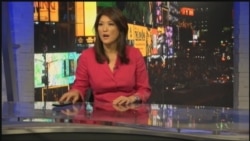Clicking through U.S. TV channels, you won't see many Asians reporting the evening news. Asian Americans — including South Asians and Pacific Islanders — are less than 3 percent of the broadcast media work force. Yet they are 6 percent of the population and the fastest growing segment.
“I think that we've gone a long way in terms of diversity in front of the camera, but we still have a ways to go behind the scenes, especially in upper management,” said Juju Chang, an anchor with ABC News in New York.
Eighty-seven-point-five percent of television news directors are Caucasian, according to the Radio Television Digital News Association. While there has been a slight increase over the last decade, the percentage of Asian American television news directors has risen only from 1.3 percent to 1.8 percent. As managers, news directors make hiring decisions.
“It’s easy to blame minorities for something that is actually an underlying cultural and structural bias within the industry,” said Angie Chuang, a journalism professor at American University. “I'm not sure that managers go into work every day and think, ‘I’m not going to hire any Asians.’ But all kinds of psychological studies and employment studies have shown that we tend to favor people who are like us.”
Gender bias
In every racial or ethnic group, there are more men in television than there are women — except for Asian Americans, according to Chuang.
Former news anchor Alan Wang offered an explanation, “I think the image for Asian women for other people is that they’re soft, they're beautiful, they're not threatening, whereas the image of the Asian male really has been the face of the enemy of this country during the last three major conflicts.”
There’s a myth among Americans that Asians are a model minority and a monolithic group of highly educated people who do not face discrimination.
Wang does not agree.
“Being an Asian American has never given me any advantages in this career," said Wang. "Nobody is sitting around saying, 'We gotta hire an Asian guy!'”
Some newsroom managers suggest there are not enough Asian applicants, and that some Asian males are not willing to go through the “grooming” necessary in smaller television markets.
A 2012 nationwide survey by the Pew Research Center shows a high percentage of Asian American men typically pursue careers in science, engineering, medicine and finance. News anchor Chang suggests cultural mores and self-selection are at play.
“Asian men are the princes of their families, and are not supposed to go into liberal arts, which is required of journalists,” she said.
There are more women than men in American University's School of Communication program.
“It’s rare to find young Asian American men who are interested in our [journalism] programs because they are starved of seeing a reflection of themselves on air. The message is, if you go into this industry you're probably not going to be successful,” said Professor Chuang.
Asian Americans continue to face the challenge of not being perceived as 'real Americans.'
"We don't always process it while watching the news, but I think over time we develop ideas and misconceptions about who is trustworthy, who is American, and who is mainstream,” said Chuang. She said the key for improvement is for Asian journalists to push for better representation in the industry, and for the news media to cover more relevant community issues, not just negative news stories.
Angry voices
People are taking to social media to tell Hollywood they are #WhiteWashedOUT.
This has helped, but Asian-Americans still remain mostly invisible on-air and in decision-making roles.
“It has a lot to do with our own culture. We are taught, as young kids not to rock the boat, don’t question authority, be quiet, work hard, and you’ll get what you deserve. Well, that doesn’t work in this country, where the squeaky wheel gets fixed first,” said Wang.
The Asian American Journalists Association is fighting for greater representation.
“I feel like even having those conversations is something that would not have happened years ago," said Niala Boodhoo, AAJA’s Vice President for Broadcast. "The fact that we're even having those conversations is a sign of progress."









